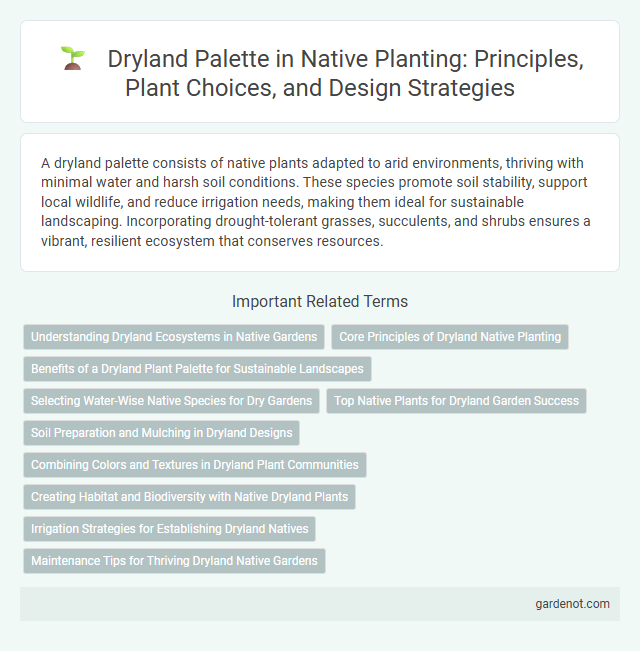A dryland palette consists of native plants adapted to arid environments, thriving with minimal water and harsh soil conditions. These species promote soil stability, support local wildlife, and reduce irrigation needs, making them ideal for sustainable landscaping. Incorporating drought-tolerant grasses, succulents, and shrubs ensures a vibrant, resilient ecosystem that conserves resources.
Understanding Dryland Ecosystems in Native Gardens
Dryland ecosystems in native gardens are characterized by low rainfall, high temperatures, and nutrient-poor soils that demand drought-tolerant plants adapted to conserve water. Native species such as sagebrush, yucca, and desert marigold thrive in these conditions, supporting local biodiversity and reducing irrigation needs. Understanding soil composition, seasonal rainfall patterns, and native plant root structures is crucial for creating sustainable dryland palettes that promote ecosystem resilience.
Core Principles of Dryland Native Planting
Dryland native planting prioritizes drought-tolerant species adapted to arid climates, enhancing water conservation and resilience. Key principles include selecting deep-rooted plants to maximize water uptake, minimizing soil disturbance to preserve natural microbiomes, and utilizing native grasses, succulents, and shrubs to stabilize soil and reduce erosion. Emphasizing biodiversity supports ecosystem health and promotes sustainable landscapes in dryland environments.
Benefits of a Dryland Plant Palette for Sustainable Landscapes
A dryland plant palette enhances sustainable landscapes by utilizing drought-tolerant native species that require minimal irrigation, reducing water consumption significantly. These plants improve soil health through deep root systems that prevent erosion, promote biodiversity, and support local wildlife habitats. Selecting drought-resistant varieties also lowers maintenance needs, making landscapes more resilient to climate variability and resource constraints.
Selecting Water-Wise Native Species for Dry Gardens
Selecting water-wise native species for dry gardens enhances sustainability and supports local ecosystems by requiring minimal irrigation. Plants such as purple coneflower (Echinacea purpurea), little bluestem (Schizachyrium scoparium), and yarrow (Achillea millefolium) thrive in arid conditions, conserving water and attracting pollinators. These drought-tolerant natives improve soil health, reduce maintenance, and create resilient landscapes suited for dryland palettes.
Top Native Plants for Dryland Garden Success
Top native plants for dryland garden success include buffalo grass, prickly pear cactus, and purple coneflower, all of which thrive with minimal water requirements. These species exhibit deep root systems and drought tolerance, making them ideal for arid climates and water-wise landscaping. Incorporating such native plants enhances soil health, supports local wildlife, and reduces irrigation needs in dryland gardens.
Soil Preparation and Mulching in Dryland Designs
Soil preparation in dryland native planting involves deep tilling to break compacted layers and enhance water infiltration for drought-tolerant species. Applying organic mulch such as shredded bark or gravel conserves moisture, reduces soil temperature fluctuations, and suppresses weed growth, crucial for dryland garden sustainability. These practices improve soil structure and nutrient availability, supporting native plants adapted to arid conditions and promoting long-term ecological balance.
Combining Colors and Textures in Dryland Plant Communities
Dryland plant communities showcase a vibrant palette by combining rich ochres, deep greens, and soft grays, creating a visually dynamic landscape. Textural diversity arises from the coexistence of spiky yucca leaves, feathery grasses, and rugged sagebrush, enhancing habitat complexity. This interplay of color and texture supports ecological resilience and provides shelter for native wildlife in arid environments.
Creating Habitat and Biodiversity with Native Dryland Plants
Native dryland plants, such as desert sage, silverleaf penstemon, and various yucca species, support habitat creation by providing essential food and shelter for pollinators, birds, and small mammals. Incorporating these drought-tolerant species enhances biodiversity by restoring natural ecosystems adapted to arid environments. Using a diverse palette of native dryland flora promotes soil health, reduces erosion, and sustains local wildlife populations in water-scarce landscapes.
Irrigation Strategies for Establishing Dryland Natives
Irrigation strategies for establishing dryland native plants emphasize minimal water use by employing targeted drip irrigation and deep soaking techniques to encourage root growth and drought resilience. Installing mulch layers reduces evaporation and maintains soil moisture, promoting healthy plant establishment in arid environments. Selecting drought-tolerant species within a dryland palette further enhances survival rates while reducing irrigation frequency during critical establishment phases.
Maintenance Tips for Thriving Dryland Native Gardens
Native dryland gardens thrive with minimal water by selecting drought-tolerant plants such as sagebrush, yucca, and desert marigold. Mulching helps retain soil moisture and reduces weed growth, while deep, infrequent watering encourages strong root development. Regularly removing invasive species and monitoring soil health ensures sustained plant vigor in arid environments.
Dryland palette Infographic

 gardenot.com
gardenot.com